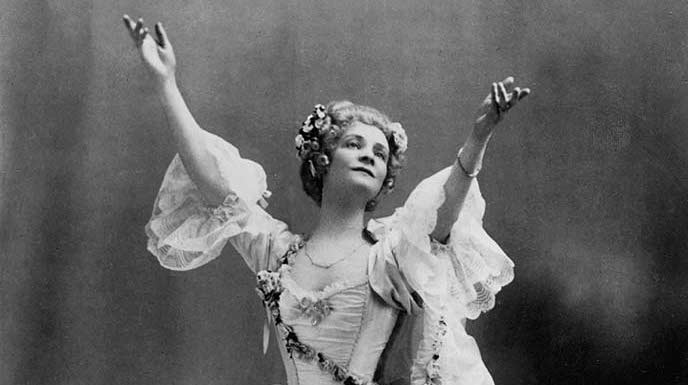OTD in early British television: 15 March 1933

John Wyver writes: On the evening of Wednesday 15 March 1933, in a programme that alkso featured popular singer Maisie Seneshall and Danish musical comedy star Eric Bertner, the celebrated dancer Adeline Genée (above, 36 years before, dancing La Camargo) gave her farewell performance by television.
Genée had been dancing professionally since 1888, when she made her debut in her uncle’s Danish company at the age of 10, and throughout the Edwardian years she was a sensation in London, across Europe and the United States. Securing this ‘farewell’, even though her last major performance was reckoned to have been in 1916, was the first great ballet coup for the producer of the BBC’s 30-line transmissions, Eustace Robb.
Wikipedia outlines Genée’s glittering career: a decade after 1897 as prima ballerina at the Empire Theatre of Varieties in London, triumphant seasons from 1907 onwards in America, and tours of Australia and New Zealand dancing among other works La Camargo (below).

For several years, Genée alternated between a season in London and one in America, although after her marriage to Frank S. N. Isitt in 1910 she gradually reduced the frequency of her appearances. Sergei Diaghilev saw her dance and immediately offered her a contract, but she refused it.
After 1916 she danced in charity appearances and commemorations, and in March 1933 she stepped before the scanner at Broadcasting House. She was partnered by Anton Dolin, an English alumnus of the Sergei Diaghilev company, and a vibrant revue star in the 1920s. Together, they performed The Love Song with her own choreography to music by Dora Bright.
Watched this on screen in the studio control room, the young ballet critic Arnold Haskell was somewhat equivocal, as he recorded in his 1934 book Balletomania:
A black-out , and another blaze of light, gradually dimming down until a small speck takes shape, That is Adeline Genée, first like a passport photo that has been left overnight in the rain, then, as the details of her costume can be distinguished, like some faded family portrait. As she dances the image takes on some meaning, perhaps because we know and love what it represents.
Nonetheless Genée’s sister-in-law saw the performance in a radio dealership in Birmingham and the ballerina’s compatriots reported receiving the picture in Copenhagen.
Leave a Reply